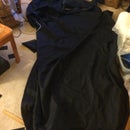Introduction: How to Go From Autodesk Inventor to CorelDRAW for Laser Cutting. I Made It at Techshop
This instructable is to explain how to go from something you made a drawing off on Autodesk Inventor to CorelDRAW so you can laser cut it. I found the first time I did this, it was not at all straight forward. I still have not found a file format that will go straight from Inventor to CorelDRAW without an intermediate program.
I made it at Techshop
http://www.techshop.ws
Step 1: Start With a Drawing in Inventor
Create a drawing in Autodesk Inventor. Make the paper size the same size as the material you will be cutting from. In this case, it is 24x4 inches. Delete the border and title box Inventor puts on the drawing by default.
Step 2: What Doesn't Work Loading Into CorelDRAW
I have tried several variations of the .dwg file from Inventor. Either Inventor or AutoCAD format produces the same results. A corrupted or unidentified file type in CorelDRAW. If you print a .pdf you get a corrupted file error importing that into CorelDRAW also. The .DWF file format isn't recognized either.
Step 3: Next Stop, Adobe Ilustrator.
If you print a .pdf file in AutoDesk Inventor that will load into Adobe Illustrator. The .dwg files from Inventor won't load there either. The .pdf file seems to be the only working thing that will load into anything. From Adobe Illustrator, save the file as a .ai Adobe Illustrator Format file.
Step 4: Finally, Something That Will Work.
The .ai file you made will load into CorelDRAW. Everything shows up. Success. It will load in with the paper size set to the correct size.
Step 5: Make Everything Hairline So It Will Cut.
The next step is to hit "edit" and "Properties" to get the right tool bar to show up on the right. Next, select your entire drawing and you need to change the line width from whatever it comes in as to "hairline" thickness. As taught in the Laser Cutter SBU class, the laser only cuts things set as Hairline. Everything else gets raster printed. If you want to have labels on your individual parts, you can go back and change the thickness of your letters to something other then hairline. You can just wait until the file is in CorelDRAW and create your labels there in non-vector form.
Step 6: So You Don't Want to Cut Your Parts Completely Out.
If you want to leave little skips in the lines so the laser doesn't completely cut out your parts you can do that now. Use the eraser tool and cut out little bits from the lines on your parts. This way they will stay attached to the base material when you are done cutting them and not fall off in the laser. I like to set the erase value to something small. 0.029 seems to work fine. It leaves enough material behind when the laser stops around it.
Step 7: Sometimes Erase Doesn't Seem to Work Quite Right.
Sometimes when you go to erase and select the part it seems to drag a bite out of the part instead of cutting the line. I don't know why some parts import in this way and others do not. It seems random so far as to which it happens to. In the below parts, which are 2 copies of the same part, 1 was normal and 1 was this way. To solve this, select the part and go over to the right and you'll see a tab that looks like a squiggly line. Under that tab will be a option called "closed loop". If closed loop is checked, then you will have this problem when trying to erase bits of line from the part. To solve it. Uncheck it. Then you can erase bits like everything else.
Step 8: Now Your Ready to Print/cut
Now everything is ready to cut. Follow the instructions from the Lasercutter SBU class for setting up the printer settings for cut and raster.













